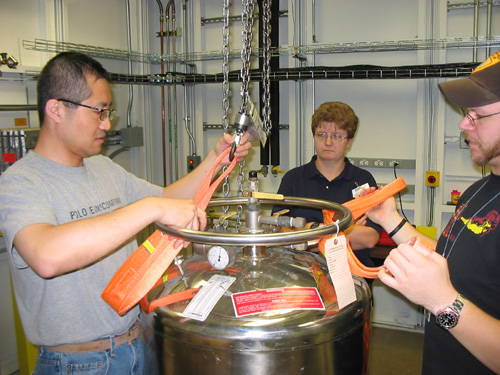 A long-standing problem has been whether the high pressure phase of iron, hexagonal close-packed, hcp-Fe, or ε-Fe is magnetic or not. Experiments since the 1960s have found no unambiguous evidence for magnetism, but first-principles theory says it should be antiferromagnetic. First-principles calculations of the hyperfine fields (HF) however, showed that the HF cancelled out at the nuclei, explaining the lack of Mössbauer signal. Former CDAC graduate student from the California Institute of Technology, Alexander Papandrew and his advisor Brent Fultz decided to see what happens if Ni is added. Papandrew did first-principles computations and found that Ni would destroy the cancellation, and HFs should be observable. Papandrew and Fultz, and a team consisting of Matthew S. Lucas, Rebecca Stevens, and Itzhak Halevy from CalTech; Michael Y. Hu and Paul Chow from HPCAT; and Maddury Somayazulu from the Geophysical Laboratory performed synchrotron Mössbauer spectroscopy (SMS) on an hcp-phase alloy of composition Fe92Ni8 compressed to 21 GPa in a diamond anvil cell and cooled to 11 K.
A long-standing problem has been whether the high pressure phase of iron, hexagonal close-packed, hcp-Fe, or ε-Fe is magnetic or not. Experiments since the 1960s have found no unambiguous evidence for magnetism, but first-principles theory says it should be antiferromagnetic. First-principles calculations of the hyperfine fields (HF) however, showed that the HF cancelled out at the nuclei, explaining the lack of Mössbauer signal. Former CDAC graduate student from the California Institute of Technology, Alexander Papandrew and his advisor Brent Fultz decided to see what happens if Ni is added. Papandrew did first-principles computations and found that Ni would destroy the cancellation, and HFs should be observable. Papandrew and Fultz, and a team consisting of Matthew S. Lucas, Rebecca Stevens, and Itzhak Halevy from CalTech; Michael Y. Hu and Paul Chow from HPCAT; and Maddury Somayazulu from the Geophysical Laboratory performed synchrotron Mössbauer spectroscopy (SMS) on an hcp-phase alloy of composition Fe92Ni8 compressed to 21 GPa in a diamond anvil cell and cooled to 11 K.  The SMS spectrum showed no hyperfine magnetic field. Ronald Cohen (Geophysical Laboratory) performed computations that showed the measurements to be below the probable magnetic ordering Néel temperature. There are two possibilities that can explain these results. First, small but significant errors in the generalized gradient approximation density functional may lead to an erroneous prediction of magnetic order, or of erroneous hyperfine magnetic fields in antiferromagnetic hcp Fe-Ni. Alternately, the presence of quantum fluctuations with periods much shorter than the lifetime of the nuclear excited state would prohibit the detection of moments by the SMS technique. This research has been published in Physical Review Letters [Papandrew et al., Phys. Rev. Lett., 97, 087202 (2006].
The SMS spectrum showed no hyperfine magnetic field. Ronald Cohen (Geophysical Laboratory) performed computations that showed the measurements to be below the probable magnetic ordering Néel temperature. There are two possibilities that can explain these results. First, small but significant errors in the generalized gradient approximation density functional may lead to an erroneous prediction of magnetic order, or of erroneous hyperfine magnetic fields in antiferromagnetic hcp Fe-Ni. Alternately, the presence of quantum fluctuations with periods much shorter than the lifetime of the nuclear excited state would prohibit the detection of moments by the SMS technique. This research has been published in Physical Review Letters [Papandrew et al., Phys. Rev. Lett., 97, 087202 (2006].
